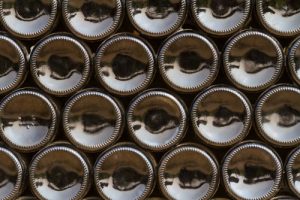
University of California, Riverside researchers have successfully used a chemical process to utilize recycled glass bottles in producing anodes for lithium batteries. The method requires minimal cost, using crushed glass bottles and an inexpensive chemical reaction to produce the anode, through which electric current flows into the battery.
The process begins with crushing the bottles and grinding them into a fine white powder, according to a press release. That provides “an abundant and relatively pure form of silicon dioxide,” to which the researchers applied a chemical reaction using magnesium to reduce the dioxide into nanostructured silicon.
Finally, the silicon nanoparticles are coated with carbon, which boosts their stability and energy storage properties. That means not only does the process create a new end market for recycled glass, but the end product is a component of a high-performance battery.
“As expected, coin cell batteries made using the glass bottle-based silicon anodes greatly outperformed traditional batteries in laboratory tests,” the release said.
According to the study’s lead author, Changling Li, a single recycled glass bottle provides enough nanosilicon for hundreds of coin cell batteries, or up to five pouch cell batteries.
“We started with a waste product that was headed for the landfill and created batteries that stored more energy, charged faster, and were more stable than commercial coin cell batteries,” Li said.